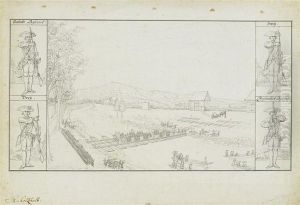Johann Rudolph Holzhalb Paintings
Johann Rudolph Holzhalb was a Swiss artist known primarily for his work as an engraver. Born in 1723 in Zurich, Switzerland, he lived during a time when Europe was undergoing significant cultural and artistic transformations. His life spanned the late Baroque and early Neoclassical periods, and his work reflects the artistic trends and interests of his era.
While comprehensive details about his personal life and artistic training are not widely documented, Holzhalb is recognized for his contributions to the printmaking world. He was active during a rich period in Swiss art history, wherein artists were engaged in both preserving traditional methods and experimenting with new techniques and subjects.
Holzhalb's engravings often featured portraits, landscapes, and religious scenes. They were characterized by their fine detail and clarity, which was a testament to his skill with the burin—a tool used by engravers to incise designs into metal plates. His works were used to illustrate books and were also distributed as standalone pieces, which helped disseminate his reputation beyond his hometown.
Holzhalb's works are an essential part of the art historical record as they provide insights into the visual culture of his time. They are also valuable for understanding the techniques and standards of printmaking in the 18th century. Despite not being as widely known as some of his contemporaries, Holzhalb's engravings remain of interest to collectors, scholars, and enthusiasts of historical prints.
Johann Rudolph Holzhalb lived a long life, passing away in 1806, leaving behind a legacy as a skilled craftsman and contributor to the art of engraving. While he may not have achieved the fame of some of the other European artists of his time, his work still holds a place in the history of Swiss art and the broader narrative of European printmaking.
